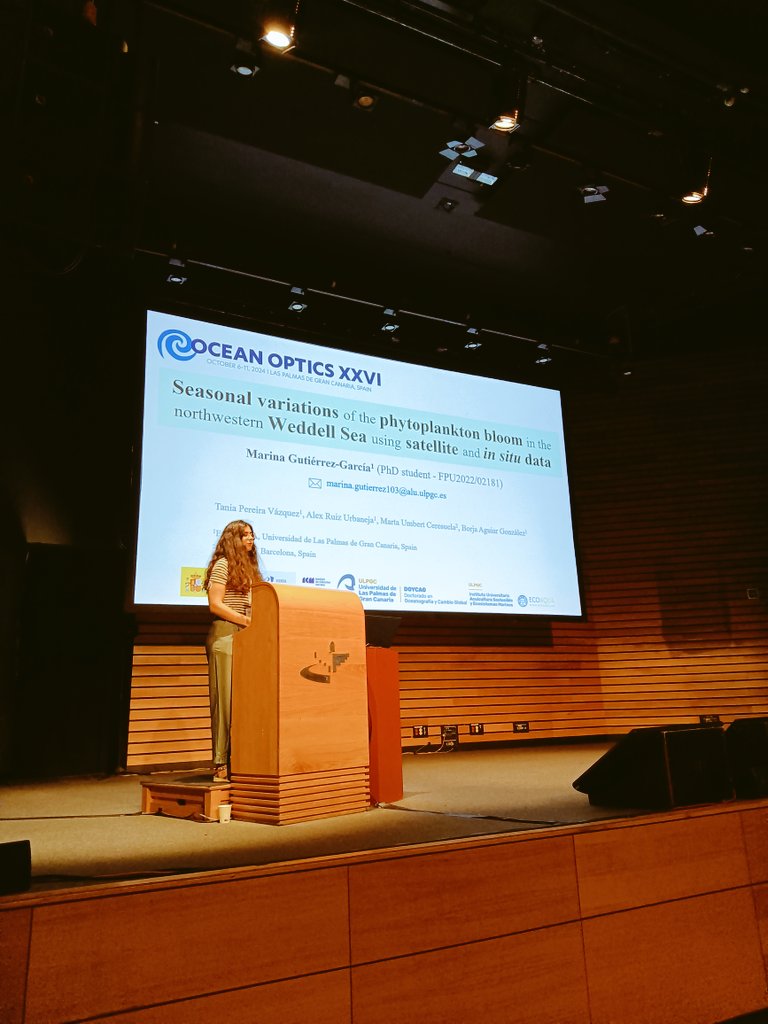The inaugural presentation, given by Antonio Juan González Ramos, a member of the BIOCON group of the ULPGC institute, revealed that the tropicalisation of the Macaronesian archipelagos such as the Canary Islands, caused by oceanic warming, has generated numerous invasions of tropical species
Four researchers from the University Institute for Research in Sustainable Aquaculture and Marine Ecosystems (ECOAQUA), of the University of Las Palmas de Gran Canaria (ULPGC), have participated in the XXVI edition of the prestigious International Congress ‘Ocean Optics’, sponsored by NASA, one of the most important events worldwide on marine scientific research that took place last week at the Palacio de Congresos de Canarias, in the Alfredo Kraus Auditorium in Las Palmas de Gran Canaria.
This event, which has more than 50 years of history and is held every two years, brought together almost 400 experts from all over the world to analyse the different advances that have been made in two essential areas for understanding the impact of climate change on marine ecosystems: the study of the colour of the ocean and marine optics.
These fields, among other aspects, allow us to understand the alterations in phytoplankton communities, microscopic organisms that play a crucial role in the absorption of atmospheric CO2 and which are also the basis of the marine food chain.
The intervention of the researcher of the Biodiversity and Conservation group (BIOCON) of ECOAQUA, Dr. Antonio González Ramos, who was in charge of the inaugural plenary conference that opened the congress under the title ‘Climate Change Monitoring by Remote Sensing in the Upwelling System of Northeast Africa and the Macaronesian Archipelagos (1994-2024)’, stood out among the participants.
Professor González Ramos was also responsible, together with Researcher Alejandro García Mendoza, also from BIOCON, for developing a specific training on the processing and obtaining of products (algal blooms) and optical images of very high spatial resolution entitled ‘Lagrangian Structures, Satellite Images and Prediction of the Evolution of Harmful Algal Blooms’, carried out in collaboration with the Institute of Mathematical Sciences of the CSIC (ICMAT/CSIC), and the Spanish technology company DES.
In addition, during the event, two members of the Physical Oceanography and Applied Geophysics (OFYGA) research group, also belonging to ECOAQUA, gave two presentations on their latest work: ‘Seasonal Variations of the Phytoplankton Bloom in the Northeast Weddell Sea Using Satellite and In Situ Data’, by Marina Gutiérrez-García, and ‘Dynamics of the Tropical Gyre in the Atlantic: Impact of the Nao through the Analysis of the Guinea Dome’, by Alex Urbaneja.

Marina Gutiérrez, during her speech.
Throughout his presentation, the expert, also a professor at the Faculty of Marine Sciences of the ULPGC, Antonio González Ramos, addressed the trajectory and experiences in spatial remote sensing of the university institution between 1996 and 2024, showing the applications and products developed at this university for the management of artisanal fisheries, climate change and the detection and monitoring of potential harmful marine events (algal blooms, oil spills).
‘Invasion' of tropical species
This presentation also highlighted that, over the last three decades, between 1994 and 2024, several studies have been published showing changes in primary productivity in upwelling systems at the eastern limits of the subtropical oceanic gyres.
During his speech, he explained that a study carried out by BIOCON in this field leads to the conclusion that the nearby Macaronesian archipelagos (Madeira, Canary Islands, Cape Verde) are experiencing a tropicalisation of their marine ecosystems due to oceanic warming, which affects both the water column and benthic and pelagic ecosystems, with numerous invasions of tropical species that have changed their distribution ranges.
As an example, the researcher said, ‘during the summer of 2017, between the months of June and October, and the summer of 2023, between August and September, extensive recurrent blooms of the diazotrophic cyanobacterium Trichodesmium invaded the coastal waters of the Canary Islands’. These blooms, ‘which decomposed as they approached the coast’, continued González Ramos, ‘were transported by local currents and winds, accumulating mainly in the leeward areas of the islands’.
 Antonio González at the ECOAQUA institute, viewing satellite images.
Antonio González at the ECOAQUA institute, viewing satellite images.
The cause, said González Ramos, ‘probably lies in the combination of unusually warm seawater temperatures and recurrent dust deposition events from the Sahara desert that favoured the development of these blooms’.
This study also showed that, despite regional climatic changes in northwest Africa, small pelagic fish species, such as sardines and anchovies, can show dramatic changes in abundance on decadal scales in response to this climate variability.
The challenge,’ concluded the BIOCON member, “is to understand the mechanisms and relationships between the different components of the food web, through which environmental constraints can influence species variability”.
This research also compared three Net Primary Production (NPP) models: the Vertically Generalised Production Model (VGPM), the Eppley-VGPM, and the Carbon-Based Production Model (CbPM). In doing so, he said, ‘we investigated long-term trends in NPP, from seasonal to interannual, in three sub-regions of the northwest African upwelling system (CanC EBUE) to identify, for the first time, temporal patterns that could support or reject the weakening hypothesis’.
Although the differences in model results were significant at regional and sub-regional scales, ‘our analysis,’ González Ramos emphasised, ‘does not show significant upward trends in NPP with any of the productivity models used’.
The researcher also presented the latest project of the Fundación Biodiversidad (Ministry of Ecological Transition and Demographic Challenge), awarded to ECOAQUA and ICMAT-CSIC (called SIRENA), last July of this year. SIRENA aims to develop an unprecedented system for monitoring marine aquaculture farms, as well as potential risks (spills, harmful planktonic blooms), based on remote monitoring with metric resolution satellites, and a 3D oceanic model of currents with very high spatial resolution ‘that will allow more efficient management of measures to avoid or minimise the potential risk to the cage farm’, he said.


